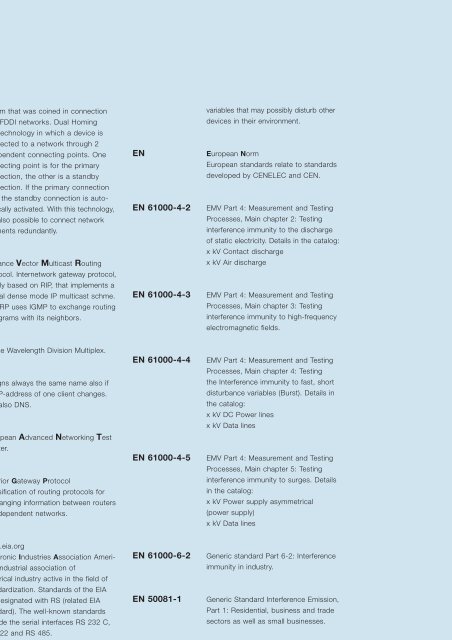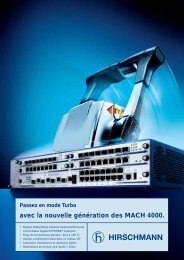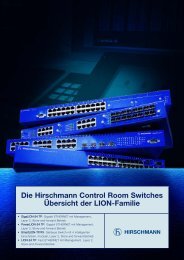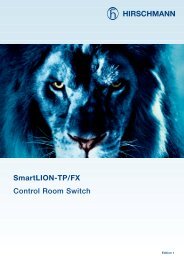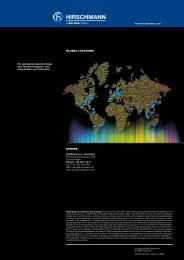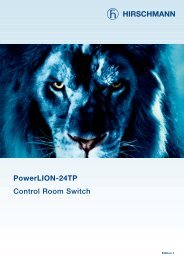Industrial ETHERNET
Industrial ETHERNET
Industrial ETHERNET
- No tags were found...
Create successful ePaper yourself
Turn your PDF publications into a flip-book with our unique Google optimized e-Paper software.
Dual Homing<br />
DVMRP<br />
A term that was coined in connection<br />
with FDDI networks. Dual Homing<br />
is a technology in which a device is<br />
connected to a network through 2<br />
independent connecting points. One<br />
connecting point is for the primary<br />
connection, the other is a standby<br />
connection. If the primary connection<br />
fails, the standby connection is automatically<br />
activated. With this technology,<br />
it is also possible to connect network<br />
segments redundantly.<br />
Distance Vector Multicast Routing<br />
Protocol. Internetwork gateway protocol,<br />
largely based on RIP, that implements a<br />
typical dense mode IP multicast schme.<br />
DVMRP uses IGMP to exchange routing<br />
datagrams with its neighbors.<br />
EN<br />
EN 61000-4-2<br />
EN 61000-4-3<br />
variables that may possibly disturb other<br />
devices in their environment.<br />
European Norm<br />
European standards relate to standards<br />
developed by CENELEC and CEN.<br />
EMV Part 4: Measurement and Testing<br />
Processes, Main chapter 2: Testing<br />
interference immunity to the discharge<br />
of static electricity. Details in the catalog:<br />
x kV Contact discharge<br />
x kV Air discharge<br />
EMV Part 4: Measurement and Testing<br />
Processes, Main chapter 3: Testing<br />
interference immunity to high-frequency<br />
electromagnetic fields.<br />
DWDM<br />
Dynamic DNS<br />
EANTC<br />
EGP<br />
Dense Wavelength Division Multiplex.<br />
Assigns always the same name also if<br />
the IP-address of one client changes.<br />
See also DNS.<br />
European Advanced Networking Test<br />
Center.<br />
Exterior Gateway Protocol<br />
Classification of routing protocols for<br />
exchanging information between routers<br />
of independent networks.<br />
EN 61000-4-4<br />
EN 61000-4-5<br />
EMV Part 4: Measurement and Testing<br />
Processes, Main chapter 4: Testing<br />
the Interference immunity to fast, short<br />
disturbance variables (Burst). Details in<br />
the catalog:<br />
x kV DC Power lines<br />
x kV Data lines<br />
EMV Part 4: Measurement and Testing<br />
Processes, Main chapter 5: Testing<br />
interference immunity to surges. Details<br />
in the catalog:<br />
x kV Power supply asymmetrical<br />
(power supply)<br />
x kV Data lines<br />
EIA<br />
www.eia.org<br />
Electronic Industries Association American<br />
industrial association of<br />
electrical industry active in the field of<br />
standardization. Standards of the EIA<br />
are designated with RS (related EIA<br />
standard). The well-known standards<br />
include the serial interfaces RS 232 C,<br />
RS 422 and RS 485.<br />
EN 61000-6-2<br />
EN 50081-1<br />
Generic standard Part 6-2: Interference<br />
immunity in industry.<br />
Generic Standard Interference Emission,<br />
Part 1: Residential, business and trade<br />
sectors as well as small businesses.<br />
EMC<br />
Electromagnetic compatibility.<br />
In EMV, both the aspects of interference<br />
immunity as well as interference emission<br />
must be kept in mind. Electrical<br />
devices, installations and systems must<br />
have a specific immunity against normal<br />
interference effects that normally occur<br />
in the planned environment. In addition,<br />
devices should not emit any interference<br />
EN 50081-2<br />
EN 50082-1<br />
EN 50082-2<br />
Generic Standard Interference Emission,<br />
Part 2: Industry.<br />
Generic Standard Interference Immunity,<br />
Part 1: Residential, business and trade<br />
sectors as well as small businesses.<br />
Generic Standard Interference Immunity,<br />
Part 2: Industry – no longer valid since<br />
the 1.4.2002.<br />
265


